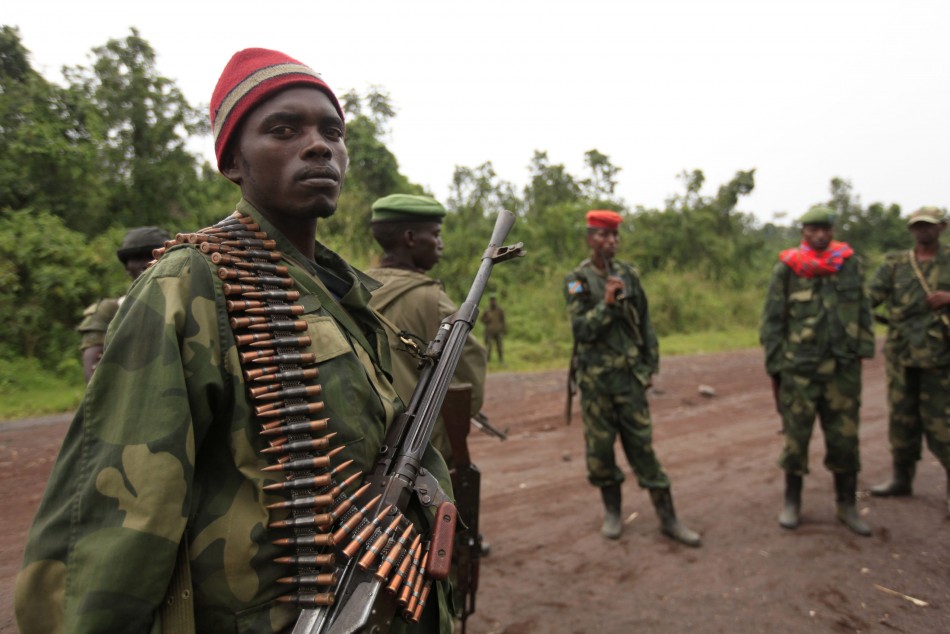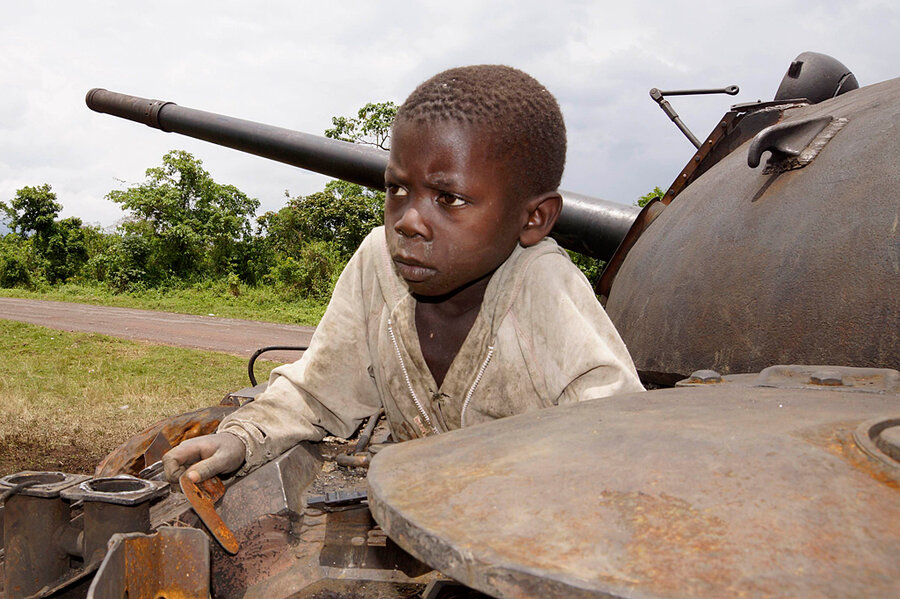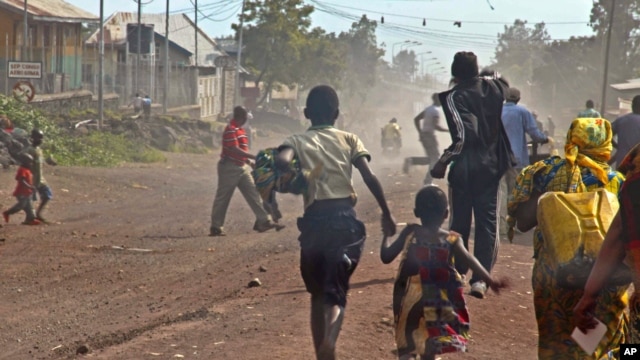
After Two Decades of War,
The Congolese People Say Enough is Enough
Tanupriya Singh / Popular Resistance
(December 20, 2022) — Peoples Dispatch spoke to Congolese activist and researcher Kambale Musavuli about the latest offensive of the M23 rebel group in the eastern part of the DRC and the broader history of proxy warfare in the region.
On Monday, December 12, a meeting was held between the M23 rebel group, the Congolese armed forces (FARDC), the commander of the joint East African Community (EAC) force, the Joint Expanded Verification Mechanism (JMWE), the Ad-Hoc Verification Mechanism, and the UN peacekeeping force, MONUSCO, in Kibumba in the Nyiragongo territory in the North Kivu province located in the eastern part of the DRC.
The meeting was held in the wake of reports of fighting between M23 and the FARDC, just days after the rebel group had pledged to “maintain a ceasefire” in the mineral-rich region. M23 is widely acknowledged to be a proxy force of neighboring Rwanda.
On Tuesday, December 6, M23 announced that it was ready to “start disengagement and withdraw” from occupied territory, and that it supported “regional efforts to bring long-lasting peace to the DRC.” The statement was issued following the conclusion of the Third Inter-Congolese Dialogue under the aegis of the East African Community (EAC) bloc that was held in Nairobi, and facilitated by former Kenyan President Uhuru Kenyatta.

Approximately 50 armed groups were represented at the meeting in Nairobi, excluding M23. The dialogue had been convened on November 28, with leaders from Kenya, Burundi, Congo, Rwanda, and Uganda also in attendance. It followed a separate dialogue process held in Angola earlier in November, which yielded a ceasefire agreement that was to take effect from November 25. This would be followed by M23’s withdrawal from the areas it had seized—including Bunagana, Kiwanja, and Rutshuru.
While M23 was not part of the talks, the group had stated that it would accept the ceasefire while reserving “the full right to defend itself.” It had also called for a “direct dialogue” with the government of the DRC, which it reiterated in its December 6 statement. The DRC government has rejected this demand, classifying the rebel force a “terrorist group.”
Lieutenant-Colonel Guillaume Njike Kaiko, an army spokesperson for the province, stated later that the meeting on December 12 had been requested by the rebels, to seek assurances that they would not be attacked by the FARDC if they withdrew from the occupied areas.
However, Lieutenant-General Constant Ndima Kongba, the governor of North Kivu, emphasized that the meeting was not a negotiation, but was held to verify the effectiveness of the resolutions under the Angola and Nairobi peace processes.
On December 1, the Congolese army had accused M23 and allied groups of killing 50 civilians on November 29 in Kishishe, located in Rutshuru Territory, 70 kilometers north of the city of Goma. On December 5, the government updated the death toll to 300, including at least 17 children. M23 rejected these allegations, claiming that just eight people had been killed by “stray bullets.”
However, the massacres were corroborated by MONUSCO, and the Joint Human Rights Office (UNJHRO) on December 7. Based on a preliminary investigation, the report stated that at least 131 civilians had been killed in the villages of Kishishe and Bambo between November 29 and 30.
“The victims were arbitrarily executed with bullets or bladed weapons,” read the document. It added that at least 22 women and five girls had been raped, and that the violence was “carried out as part of a campaign of murders, rapes, kidnapping and looting against two villages in the Rutshuru Territory in retaliation for clashes between M23 and the Democratic Forces for the Liberation of Rwanda (FDLR-FOCA), and armed groups Mai-Mai Mazembe, and Nyatura Coalition of Movements for Change.”
The report added that M23 forces had also buried the bodies of those killed in “what may be an attempt to destroy evidence.”
The massacres in Rutshuru are not isolated incidents, but instead are the latest in a long series of atrocities committed in the DRC for almost 30 years, estimated to have killed 6 million Congolese people. While M23 became prominent following its capture of Goma in 2012, and again with the resumption of its latest offensive in March, it is possible to trace the group’s trajectory throughout the preceding decades and, with it, the enduring imperialist interests fueling the violence in the Congo.
Decades Of Proxy Warfare
“The DRC was invaded by its neighbors, Rwanda and Uganda, in 1996 and 1998. While both countries officially withdrew from the country following the signing of bilateral accords in 2002, they continued to support proxy rebel militia groups,” explained Kambale Musavuli, a Congolese researcher and activist, in an interview with Peoples Dispatch.
M23 is an acronym of the “March 23 Movement” formed by soldiers within the Congolese army who were members of a former rebel group, the National Congress for the Defence of the People (CNDP). They accused the government of refusing to honor a peace agreement signed on March 23, 2009, which had led to the CNDP’s integration into the FARDC. In 2012, these former CNDP soldiers rebelled against the government, forming M23.
However, Musavuli points out that claims regarding the peace agreement were false: “The reason they left was that one of their commanders, Bosco Ntaganda, was threatened with arrest.” The International Criminal Court had issued two warrants for his arrest, in 2006 and 2012, on charges of war crimes and crimes against humanity. It was under his command that CNDP troops massacred an estimated 150 people in the town of Kiwanja in North Kivu in 2008.
Following the presidential election in 2011, there was pressure on the Congolese government to turn Ntaganda in, Musavuli added. He finally surrendered in 2013, and was convicted and sentenced by the ICC in 2019.
A few months after it was formed, the M23 rebel group captured Goma in November, 2012. However, the occupation was short-lived, and by December the group had withdrawn. Around 750,000 Congolese people were displaced by the fighting that year.
“At the time, it became clear to the international community that Rwanda was supporting a rebel force in the Congo. You had the US and European countries putting pressure on Rwanda, following which it wound down its support.” Congolese forces had also been supported by troops from countries in the Southern African Development Community (SADC)- particularly South Africa and Tanzania, working alongside UN forces.
While the M23 would re-emerge ten years later, its history was also not limited to the CNDP. “The CNDP’s predecessor was the Congolese Rally for Democracy (RCD), a rebel group backed by Rwanda that waged a war in the Congo between 1998 till 2002, when a peace accord was signed, following which the RCD joined the Congolese army,” Musavuli said.
“The RCD itself was preceded by the AFDL (the Alliance of Democratic Forces for the Liberation of Congo-Zaire), a Rwandan-backed force which invaded the DRC in 1996 to topple the regime of Mobuto Sese Seko.” Subsequently, AFDL leader Laurent Désiré Kabila was brought to power. However, Musavuli adds, disagreements soon grew between the AFDL and the new Congolese government mainly around issues related to the exploitation of natural resources and sub-political lines.

A year into power, Kabila ordered the removal of all foreign troops from the country. “Within the next few months, the RCD was formed,” Musavli said.
What is also of particular note throughout this history is the repeated attempt, through various peace accords, to integrate these rebel forces into the Congolese army.
“This was never the will of the Congolese people, it has been imposed,” Musavuli explained. “Since 1996, there have been numerous peace negotiation processes usually led by Western countries. Following the 2002 peace agreement, we had four vice presidents and one president. This was because of the international community, specifically former US ambassador William Swing.”
“When the Congolese went for the peace negotiations to South Africa, the civil society groups had stressed that they did not want former rebels to have any position in government during the transition period. Swing swayed the discussion, given that the US has always influenced peace negotiations of the DRC, and came up with a formula which saw four warlords as vice presidents of the country.”
The Congolese parliament has now taken a firm stance against any such possibility by declaring M23 a ‘terrorist group’ and prohibiting its integration into the FARDC.
Foreign Interference And Resource Theft
US interference in the DRC has been apparent since its independence, Musavuli added—in the assassination of Patrice Lumumba, support given to the brutal regime of Mobuto Sese Seko, the invasions of the 1990s and the subsequent peace talks, and changes to the country’s constitution in 2006 to allow Joseph Kabila to contest the election. “In 2011, the US was one of the first countries to recognize the results of the rigged elections. Analysis at the time showed that in doing so, the US was betting on stability rather than democracy,” Musavuli said.
Three months later, the M23 uprising began. “It is the same rebel force over twenty years, with the same soldiers and the same commanders, to serve the interests of Rwanda, which itself is a strong US ally in the so-called War on Terror. And what are Rwanda’s interests in the Congo- its land and its resources,” he added.
As such, “the conflict in the DRC must not be seen as fighting between a rebel group and the Congolese government.” This was reiterated by activist and writer Claude Gatebuke, “This is not an ordinary rebellion. It is an invasion of the Congo by Rwanda and Uganda”.

Even though Kigali has repeatedly denied backing M23, evidence confirming the allegation has been presented repeatedly, most recently in a report by a UN group of experts in August. The report shows that the Rwandan Defense Force (RDF) had been supporting M23 since November 2021, and engaging in “military operations against Congolese armed groups and FARDC positions,” unilaterally or with M23. In May, the Congolese army had also captured two Rwandan soldiers in its territory.
Musavuli added that this kind of foreign-backing was also apparent in the fact that the M23 had access to extremely sophisticated weapons and equipment.
This link becomes more explicit in the context of the ceasefire negotiations. “In order for M23 to accept the ceasefire, Uhuru Kenyatta first had to call the Rwandan President Paul Kagame. Not only that, on December 5, the US State Department issued a press communique stating that Secretary of State Antony Blinken had spoken to President Kagame, basically asking Rwanda to stop interfering in the DRC. What happened the next day? The M23 put out a statement saying that they were no longer fighting,” Musavuli highlighted.
Rwanda has justified its invasions of the DRC under the pretext of fighting the Democratic Forces for the Liberation of Rwanda (FDLR), a Hutu rebel group in the DRC accused of committing the genocide in Rwanda in 1994. “But Rwanda is not going after the FDLR, it is going after the mines. How are Congo’s minerals finding their way into Kigali?”
Similarly, Musavuli stated, Uganda had created a pretext to invade the Congo and exploit its resources- the Allied Democratic Forces (ADF). “Uganda has claimed that the ADF are “jihadists” who are seeking to topple the government. What we do know is that the ADF are Ugandans who have been fighting the Museveni regime since 1986.”
“A bogus connection has been created between the ADF and ISIS to bring in US presence… it creates a pretext to have US soldiers in the Congo in the name of the fight against “Islamic fundamentalism” and “jihadists”.”
As the violence has continued, the people of the Congo have also staged massive protests in 2022, which also saw expressions of a strong anti-US sentiment, including in the form of protesters carrying the Russian flag. “The Congolese have seen that Rwanda has continued to receive support from the US even as it has continued to kill and support rebel groups in the DRC.”, Musavuli added.
“After two decades of war, the Congolese people are saying enough is enough.”
Posted in accordance with Title 17, Section 107, US Code, for noncommercial, educational purposes.